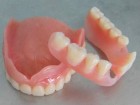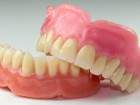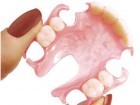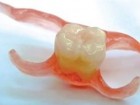Removable prosthetics
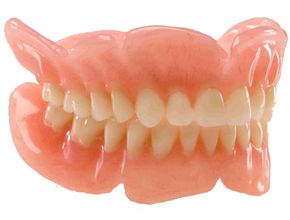
Removable dentures recommended if the patient loses one or more teeth.
Prosthetics with removable dentures is the installation of dental structures, which, if necessary, can be removed.
Removable dental structures allow you to restore the functionality of the dentition, as well as to eliminate the aesthetic defects of the teeth in the event that fixed prosthetics is impossible.
Modern dentistry in its arsenal has manufacturing technologies for removable structures that are extremely convenient to use, durable and highly aesthetic.
Advantages and disadvantages
Pluses of removable dentures:
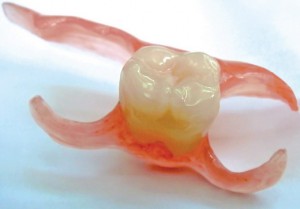
- Ease of use design.
- Aesthetics.
- Fairly easy prosthesis care.
- Strength.
- For a temporary prosthesis - ideal.
- Lightweight, comfortable design.
- They have no age restrictions.
- Are made individually for the patient.
- Affordable for the price.
Cons of removable dentures:
- Insufficiently secure fit.
- They require frequent removal for hygiene procedures.
- Long addiction to the design.
- Discomfort during eating.
- Removable acrylic tooth designs can cause allergies and toxic effects.
- Removable dentures wear out quickly and are prone to breakage.
- Diction is often disturbed.
- A regular visit to the dentist to examine the gums and jaws.
- Short design life.
How a removable prosthesis works
- The design of the removable denture consists of a base and artificial teeth. The removable tooth structure can be attached to the hard palate, or attached to the abutment teeth, if any.
- A removable denture is attached to the abutment teeth or implants using locks or clasps. Locks are a more modern device for fixing the dental structure. With the help of clasps, the structure is securely fixed. Tooth enamel is not damaged, but the clasp is visible with a smile.
- The castle consists of two parts, one of which is fixed on the abutment, and the second is not the prosthesis. The prosthesis is fixed like a button on clothes. The design on the locks looks more aesthetic than the one that is mounted on the clasps. The castle is not visible in a smile and is very reliable.
- Modern orthopedics suggests using implants in the absence of supporting teeth as a support for a removable prosthesis.
Video: “Removable prosthesis”
Types of removable dentures
Removable dental structures are divided into:
- Complete dentures removable. Used in the complete absence of teeth on the jaw. Such prostheses include plastic and nylon structures.
- Partial removable dentures. Recommended in the absence of one (for example, a removable denture butterfly) and more teeth in a row. Such designs are used for defects in the dentition.The prosthesis can be used as a temporary construction for dental interventions. Partially - removable structures include plastic, nylon, clasp dentures.
- Conditionally removable dentures. Used to restore one tooth. The design is fixed to adjacent abutment teeth using metal tabs. They are fixed by gluing, or using special cement.
Partial removable structures include:
- Plate dentures. They are used in the absence of chewing teeth or with the loss of several teeth in a row.
- Segments of dentitions or removable sectors are one-sided structures, they are used for the loss of several teeth on one side of the jaw.
- Immediate prostheses. They are temporary structures.
- Clasp dentures. They are popular for the loss of a large number of teeth.
Which are better?
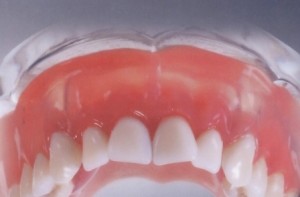
- Removable dental structures made of nylon are lightweight, flexible and soft, but also durable. Acrylic dentures are not as plastic as nylon ones and because of this, the probability of their failure is high. At the same time, acrylic plastic is a fairly lightweight and dense material. Therefore, an acrylic prosthesis, whether it is an upper or lower dental structure, is able to maintain its shape for a long time.
- If the patient is allergic to acrylic plastic or metal, nylon prosthetics becomes an urgency as an alternative to clasp or plate.
- In terms of aesthetic characteristics, nylon designs are good in color and shape. The appearance of dentures made of nylon is not subject to change throughout the entire period of use. But removable nylon structures have one drawback - the transmission of artificial teeth through the base of the prosthesis.
- For a more solid fixation of acrylic structures, mini-implants are placed. The base of the removable denture is fixed on them. When prosthetics with nylon structures, this technique is not applied. Clasp prosthesis, unlike nylon and acrylic, evenly distributes the load between the gums and the remaining teeth.
What are they made of?
Removable dental prosthesis designs are made from acrylic dental plastic by hot and cold polymerization, or using injection molding techniques.
The use of such plastics allows the structure to retain its properties for a long time - color, strength, density and shape.
Nylon tooth structures are made of nylon.
How to fix in the mouth
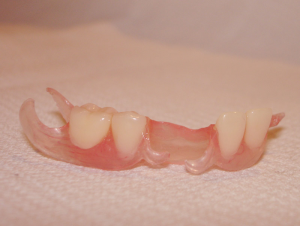
- The fixation of complete removable structures made of acrylic and nylon occurs by means of their suction to the gums. When replacing a complete dentition, this method of fastening the structure is unreliable.
- For better adhesion, special glue is recommended. In order to better attach acrylic plastic structures, mini-implants are installed, then a prosthesis is fixed on them.
- Partially - removable structures can be mounted on the abutment teeth with the help of clasps or attachments. Clasps are made of metal, which has springy properties. Thanks to them, the clasp is able to reliably hold the structure in the oral cavity during meals, during conversation, etc. Clasps are attached at the base of the abutment. This type of attachment is used in a partial plate prosthesis.
- Another type of fastening is with the help of locks (attachments), which consist of two parts. One of them is located at the base of the prosthesis or inside the artificial tooth, and the second is in the root of the tooth or under the crown of the supporting tooth. This type of mount is more reliable and aesthetic.
Recommendations for use
Patients who use removable dentures are not recommended:
- Use sticky and viscous products, because they can contribute to damage to the prosthesis.
- For the first time after installation, you should refrain from eating solid food. It should be soft and well chopped.
- Some dentists advise in the first months of using the prosthesis to keep it in a humid environment: in the afternoon - in the mouth or in a glass with a disinfectant. They explain this approach by the fact that a moist environment contributes to the final consolidation of the structural properties.
If the removable design causes discomfort in the mouth or rubs the gums, you must consult your dentist to correct the prosthesis.
Indications
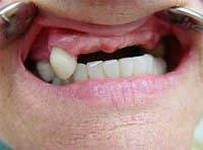
- End defects in the dentition.
- Partially or completely missing chewing teeth on the jaw.
- Periodontal disease.
- Periodontitis.
Contraindications
- Atrophy of the gums is very pronounced.
- Increased compliance of the gingival mucosa.
- Inflammation of the gums and oral cavity.
- Teething.
- Low height of present teeth.
How to get used to it faster
- The first few hours after installing the prosthesis, increased salivation may occur, a gag reflex may occur. To reduce its manifestation, it is recommended to apply a sucking candy to the sky and, holding it with its tongue, dissolve it.
- To accelerate addiction to the design - frequent rinsing of the oral cavity with warm water.
- To improve diction, you need to talk more.
- There is a need on both sides of the prosthesis. This is done in order to reduce the mobility of the structure.
- To acquire the chewing skill with the help of the design, you can eat sliced fruit.
- Most dentists recommend: the first time after prosthetics, leave a removable structure in your mouth, even at night, for better getting used to it.
If the prosthesis presses on the gums, he needs a correction. Full addiction to the design occurs in one to one and a half months.
Removable Denture Care
Removable tooth designs require careful care:
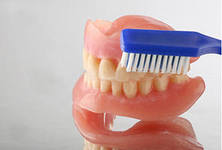
- They must be thoroughly cleaned of plaque and food debris, during the day after meals and always before bedtime.
- The structure must be cleaned with a specially designed product.
- Each time after eating, it is necessary, having removed the denture, thoroughly rinse the oral cavity with water. Then, put the structure back in place.
- When using removable dental structures, it is not recommended to eat solid, sticky and sticky foods, as well as chewing gum.
- Protect the prosthesis from falling and bumps, because artificial teeth for removable dentures are primarily damaged.
Prices for removable dentures
The price of removable dental structures depends on the material from which they are made.
A full denture on the entire jaw made of acrylic is cheaper than nylon. Partial price a removable denture depends on the quality of the artificial teeth included in the design.
| Type of removable denture | Price (in rubles) |
| Full denture with imported teeth | 70000 |
| Partial removable denture with imported teeth (7 - 12 pcs.) | 19000 — 27000 |
| One-tooth removable denture | 3000 |
| Two-tooth removable denture | 5500 |
| Immediate prosthesis | 19800 |
| Full removable nylon prosthesis | 25500 |
FAQ
- Question: Can I leave a denture in my mouth all night?
Answer: After the evening hygiene to clean the prosthesis and oral cavity, the design is perfectly acceptable to leave in the mouth for the night.
- Question: Which removable denture is more aesthetic?
Answer: Removable nylon dentures are more aesthetic, because the shape and color corresponds to the natural color of the gums and teeth.
- Question: In what cases are removable dentures used?
Answer: Removable structures are used when one or more chewing teeth are missing.
- Question: While implants will be installed, is it possible to wear a removable denture during this period?
Answer: Yes, the installation of temporary prostheses is possible on the same day as the implant implantation. Both removable and non-removable structures may be temporary.
Photos before and after removable prosthetics
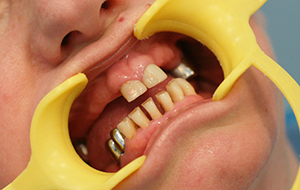 |
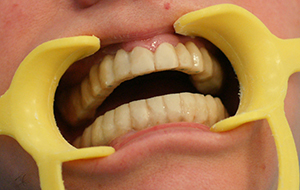 |
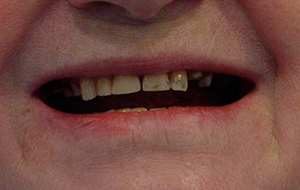 |
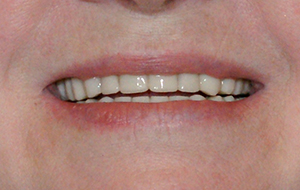 |
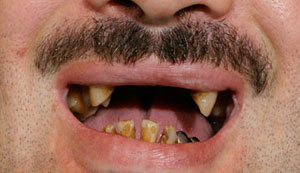 |
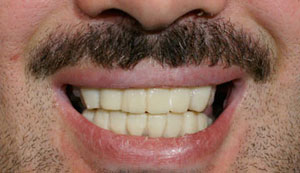 |

